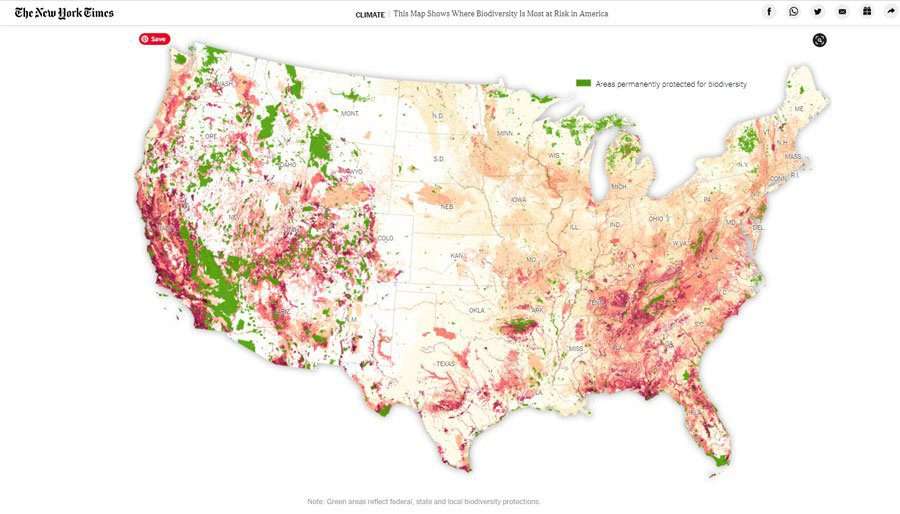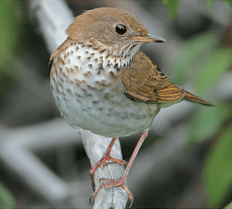
Adirondacks region stands out as conservation leader on national biodiversity map
By Cayte Bosler
Deep red spells doom on a new national map of wild things.
The color scale ranges from dark green to blood red based on how much biodiversity has declined in the continental United States, showing areas of risk for plants and animals threatened with extinction. In the Northeast, the Adirondacks offer refuge to eyes combing the map, with its pop of bright green in the troubling vastness of red.
The map, published by the New York Times, resulted from a partnership between Esri, a pioneer in digital mapping, and NatureServe, a nonprofit conservation research group. “If you can’t measure it, you can’t save it,” goes the sustainability axiom.
Visuals like these offer policymakers and the public a chance to understand where species are most imperiled and then act.
Without intervention, places shaded with red remain vulnerable to losing nonhuman life. Based on a complex collection of data like species distribution, population size, and habitat preference, this comprehensive picture is like a report card for biodiversity – the variety of species and their genetic diversity in an ecosystem. Green areas on the map have achieved a level of protection for wildlife and plants that has become mostly aspirational for much of the country.

Adirondacks are a bright spot
The Adirondacks arguably serve as a world-class model and an originator in the United States for how to manage public lands to conserve nature. Conservation values are codified in the 1894 New York State Constitution’s “forever wild” clause. That landmark decision sprung forth the natural bounties evident on the map compared to the rest of the state and, even more so, the rest of the nation.
These strict environmental guidelines help block the decline of wildlife whose leading threat globally is habitat destruction. Because environmental protections are enshrined in the state’s constitution, it is a lot more difficult to amend, bend or ignore compared with other national legislation such as the United States’ Endangered Species Act (ESA), or even the Global Convention of Biological Diversity (CBD), a framework without binding laws.
According to the United States Geological Survey, about 13% of the country is classified as protected and managed for biodiversity. The Biden administration wants that number to reach 30%, as part of the planetary push known as “30 by 30,” to bolster legal protections for 30% of the world’s land and waters by 2030.

Biodiversity seen as buffer against climate change impact
The study behind the biodiversity map comes on the coattails of a damning report produced by the Intergovernmental Panel on Climate Change (IPCC), published in sections over the first week of March. It’s the most comprehensive assessment on climate change since 2014 and makes plain that without significant, coordinated action, the world is on track to surpass 1.5 degrees Celsius of warming – a threshold that scientists warn is likely to usher in catastrophic and irreversible effects. “Any further delay,” the report states, and humans miss a chance to “secure a livable and sustainable future for all.”
That future must include the nonhuman world, too, the report emphasizes. If protected by sound policy and land management practices, intact ecosystems brimming with biodiversity could also protect us. As biodiversity declines, human communities are more vulnerable to sudden environmental shifts like floods, droughts, wildfires and an increased risk of invasive species disease, a lack of fresh water and healthy food.
“If you were to remove parts from a computer or car randomly, everyone knows that both those systems will become less reliable or very likely stop working,” said Shahid Naeem, director of the Earth Institute Center for Environmental Sustainability. “The same thing happens to ecosystems when they lose their species.”
Special Offer
Subscribe to the Adirondack Explorer app for only $8!
Access a year’s worth of content from Adirondack Explorer magazine
on your mobile device, which includes our annual Outings Guide.
Use the code EXPLORE at checkout
"spot" - Google News
March 08, 2022 at 05:11PM
https://ift.tt/EKD0SkZ
A bright spot on a bleak map - Adirondack Explorer
"spot" - Google News
https://ift.tt/DY7KOSl
https://ift.tt/Zkmbfns
Bagikan Berita Ini

















0 Response to "A bright spot on a bleak map - Adirondack Explorer"
Post a Comment